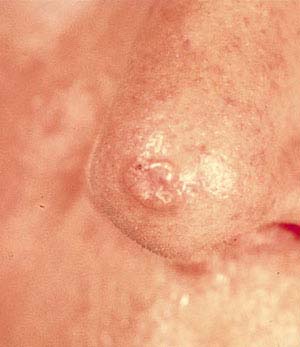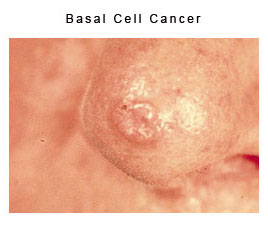Basal Cell Cancer
Ralph A. Massey, MD — Santa Monica & Encino, CA

-
What is basal cell carcinoma?
 A. Basal cell carcinoma is the commonest form of skin cancer. In fact it is the most common form of cancer of any type worldwide. Basal cell cancer will only rarely metastasize; rather it infiltrates the surrounding area destroying tissue.
A. Basal cell carcinoma is the commonest form of skin cancer. In fact it is the most common form of cancer of any type worldwide. Basal cell cancer will only rarely metastasize; rather it infiltrates the surrounding area destroying tissue.
-
What causes basal cell carcinoma?In the vast majority of cases, it is thought to be caused by exposure to the harmful ultraviolet rays of the sun. It is becoming more common, perhaps because people may be spending more time outdoors. Some believe that the decrease in the ozone layer is allowing more ultraviolet radiation from the sun to reach us and so increasing our risk. Other risk factors include, prior ultraviolet light or x-ray treatments (such as radiation used for acne treatments in the 1940-1960) and immunosupression (such as in organ transplant patients).
-
What does basal cell cancer look like?
Basal cell cancer most often appears on sun-exposed areas such as the face, neck, ears, chest and back. These tumors can have several different forms. The most common appearance of basal cell cancer is that of a small dome-shaped bump that has a pearly translucent color. Blood vessels may be seen on the surface. Basal cell cancer can also appear as a pimple-like growth that heals, only to come back again and again. A less common form, called morpheaform, looks like a smooth white, pink or yellowish waxy scar. A very common sign of basal cell cancer is a sore that bleeds, heals up, only to recur again.
-
I have already had one basal cell cancer. Am I at risk for getting another?If you have already had one basal cell cancer studies have shown that you are at a 40% risk of getting a second basal cell cancer within five years. It is important to follow closely with your dermatologist and be alert to any suspicious lesions or non-healing sores that develop on your skin.
-
I have had basal cell cancer. Am I at risk of developing other skin cancers, such as melanoma?Both basal cell carcinoma and melanoma most often occur in fair completed patients with a history of excess sun exposure. Perhaps because of this similar risk profile, individuals who have had multiple basal cell cancers are statistically at an increased risk for melanoma. However, it is important to know that basal cell cancer does NOT turn into melanoma.
-
Is there anything I can do to prevent basal cell cancer?In the vast majority of cases basal cell cancer is caused by ultraviolet radiation from the sun. Proper sun protection may help to prevent the development of further basal cell cancers. Because 80% of lifetime sun exposure is acquired in childhood by age 20, careful sun protection in children may effectively prevent basal cell cancer later in life. Follow these simple steps: Avoid “peak” sunlight hours — 10 a.m. until 4 p.m. — when the sun’s rays are the strongest. Seek shade whenever possible. Remember “No shadow, seek the shade!” If your shadow is shorter than you are, the damaging rays of the sun are at their strongest and you’re likely to sunburn. Wear protective clothing, including a wide-brimmed hat, sunglasses and long-sleeved shirt and pants during prolonged periods of sun exposure. Apply a broad spectrum sunscreen with a Sun Protection Factor (SPF) 15 or higher, 15 – 30 minutes before going outdoors and reapply every two hours, especially when involved in outdoor activities such as gardening or swimming.
Prevention and Treatment
Prevention is an important way to combat all skin cancers. To learn more about skin cancer prevention, visit our prevention page. To learn more about the treatment of basal cell skin cancer, visit our skin cancer treatment page.Your Basal Cell Cancer will be performed by Dr. Ralph A. Massey himself, within his certified outpatient surgery center in Santa Monica.
“Truly greateful for the high quality of care”
Read full testimonial“so much expertise, caring and friendship”
Read full testimonial“What an amazing healer!”
Read full testimonial“Simply the best of the best”
Read full testimonial“This doctor walks on water”
Read full testimonial